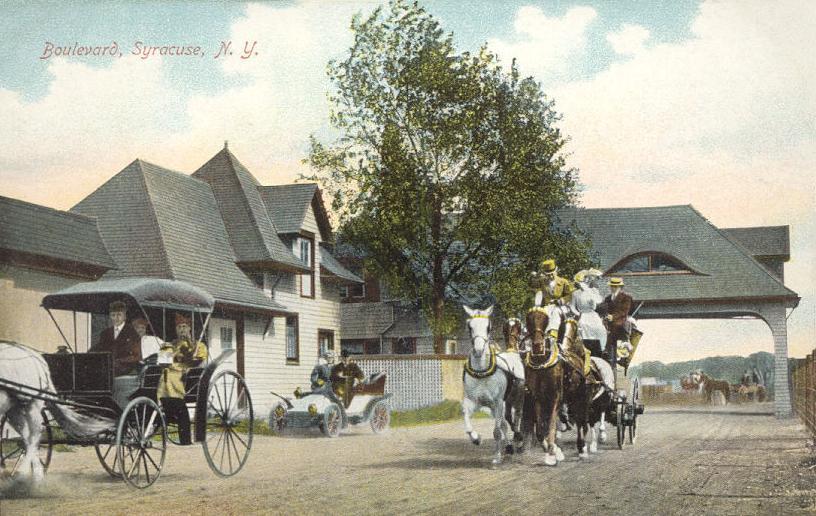|
Hills Building
The Hills Building is a high-rise office building located in Syracuse, New York. History The building was designed by architect Melvin L. King. Construction works were completed in 1928. Its first owner was Clarence Hills, who, back in 1910, had founded one of the largest real estate companies in Syracuse. The building is a contributing property within the Montgomery Street–Columbus Circle Historic District in Downtown Syracuse since its creation in 1980. Description The building is and 12 floor tall, making it the twelfth highest building in Syracuse as of 2021. The building is of steel-frame construction and is clad with stone and brick. It features a mixture of Art Deco and Gothic Revival architecture. The verticality of the façades is emphasized by the uninterrupted rising pilasters. Ornamentation includes Gothic-like detailing on the ground floor retail façades, a high-up gargoyle that extends toward the Montgomery-East Fayette intersection, and stone shield ... [...More Info...] [...Related Items...] OR: [Wikipedia] [Google] [Baidu] |
Syracuse, New York
Syracuse ( ) is a City (New York), city in and the county seat of Onondaga County, New York, Onondaga County, New York, United States. It is the fifth-most populous city in the state of New York following New York City, Buffalo, New York, Buffalo, Yonkers, New York, Yonkers, and Rochester, New York, Rochester. At the United States Census 2020, 2020 census, the city's population was 148,620 and its Syracuse metropolitan area, metropolitan area had a population of 662,057. It is the economic and educational hub of Central New York, a region with over one million inhabitants. Syracuse is also well-provided with convention sites, with a Oncenter, downtown convention complex. Syracuse was named after the classical Greek city Syracuse, Sicily, Syracuse (''Siracusa'' in Italian), a city on the eastern coast of the Italian island of Sicily. Historically, the city has functioned as a major Crossroads (culture), crossroads over the last two centuries, first between the Erie Canal and its ... [...More Info...] [...Related Items...] OR: [Wikipedia] [Google] [Baidu] |
Syracuse University Press
Syracuse University Press, founded in 1943, is a university press that is part of Syracuse University. It is a member of the Association of American University Presses. History SUP was formed in August 1943 when president William P. Tolley promised Thomas J. Watson that the university will organize a press to print IBM's ''Precision Measurements in the Metal Workings Industry''. Matthew Lyle Spencer of the School of Journalism became the first chair of the board of directors and Lawrence Siegfried was the first editor. About The areas of focus for the Press include Middle East studies, Native American studies, peace and conflict resolution, Irish studies and Jewish studies, New York State, television and popular culture, sports and entertainment. The Press has an international reputation in Irish studies and Middle East studies. In March 2017, SU Press received HumanitieOpen Book Programaward from the National Endowment for the Humanities. Since October 2020, SU press has p ... [...More Info...] [...Related Items...] OR: [Wikipedia] [Google] [Baidu] |
Emporis
Emporis GmbH was a real estate data mining company that was headquartered in Hamburg, Germany. The company collected data and photographs of buildings worldwide, which were published in an online database from 2000 to September 2022. On 12 September 2022, the managing director of CoStar Europe posted a letter on Emporis.com, informing its community members of the decision which had been made to retire the Emporis community platform, effective 13 September 2022. Emporis offered a variety of information on its public database, Emporis.com. Emporis was frequently cited by various media sources as an authority on building data. Emporis originally focused exclusively on high-rise buildings and skyscrapers, which it defined as buildings "between 35 and 100 metres" tall and "at least 100 metres tall", respectively. Emporis used the point where the building touches the ground to determine height. The database had expanded to include low-rise buildings and other structures. It used a ... [...More Info...] [...Related Items...] OR: [Wikipedia] [Google] [Baidu] |
Contributing Property
In the law regulating historic districts in the United States, a contributing property or contributing resource is any building, object, or structure which adds to the historical integrity or architectural qualities that make the historic district significant. Government agencies, at the state, national, and local level in the United States, have differing definitions of what constitutes a contributing property but there are common characteristics. Local laws often regulate the changes that can be made to contributing structures within designated historic districts. The first local ordinances dealing with the alteration of buildings within historic districts was passed in Charleston, South Carolina in 1931. Properties within a historic district fall into one of two types of property: contributing and non-contributing. A contributing property, such as a 19th-century mansion, helps make a historic district historic, while a non-contributing property, such as a modern medical clinic ... [...More Info...] [...Related Items...] OR: [Wikipedia] [Google] [Baidu] |
Montgomery Street–Columbus Circle Historic District
The Montgomery Street–Columbus Circle Historic District is located in Syracuse, New York. Includes maps and 11 photos from 1979. It was added to the National Register of Historic Places in 1980. Contributing properties References Neoclassical architecture in New York (state) Beaux-Arts architecture in New York (state) Renaissance Revival architecture in New York (state) Neighborhoods in Syracuse, New York Historic districts in Onondaga County, New York Buildings and structures in Syracuse, New York Historic districts on the National Register of Historic Places in New York (state) National Register of Historic Places in Syracuse, New York {{OnondagaCountyNY-NRHP-stub ... [...More Info...] [...Related Items...] OR: [Wikipedia] [Google] [Baidu] |
Downtown Syracuse
Downtown Syracuse is the economic center of Syracuse, New York, and Central New York, employing over 30,000 people, and housing over 4,300. It is also one of the 26 officially recognized neighborhoods of Syracuse. History Downtown Syracuse, as the rest of the city, grew as a result of the city's salt industry and its location on the Erie Canal. For over a century, it was also the retail and entertainment center of Central New York, with large department stores such as Chappell's, The Addis Co., Flah's, E.W. Edwards, Woolworth's, Grant's, Lincoln Stores, The Mohican, David's, Kresge's, Clark Music Co., Dey Brothers, and Sibley's. This attribute began to fade with development of large suburban malls, with the final blow in 1992 when the combined Addis & Dey's department store became the last major store to leave downtown. South Salina Street South Salina Street between Erie Boulevard and West Onondaga Street was the main north-south artery of Downtown Syracuse and was amo ... [...More Info...] [...Related Items...] OR: [Wikipedia] [Google] [Baidu] |
Art Deco Architecture
Art Deco, short for the French ''Arts Décoratifs'', and sometimes just called Deco, is a style of visual arts, architecture, and product design, that first appeared in France in the 1910s (just before World War I), and flourished in the United States and Europe during the 1920s and 1930s. Through styling and design of the exterior and interior of anything from large structures to small objects, including how people look (clothing, fashion and jewelry), Art Deco has influenced bridges, buildings (from skyscrapers to cinemas), ships, ocean liners, trains, cars, trucks, buses, furniture, and everyday objects like radios and vacuum cleaners. It got its name after the 1925 Exposition internationale des arts décoratifs et industriels modernes (International Exhibition of Modern Decorative and Industrial Arts) held in Paris. Art Deco combined modern styles with fine craftsmanship and rich materials. During its heyday, it represented luxury, glamour, exuberance, and faith in social a ... [...More Info...] [...Related Items...] OR: [Wikipedia] [Google] [Baidu] |
Gothic Revival Architecture
Gothic Revival (also referred to as Victorian Gothic, neo-Gothic, or Gothick) is an architectural movement that began in the late 1740s in England. The movement gained momentum and expanded in the first half of the 19th century, as increasingly serious and learned admirers of the neo-Gothic styles sought to revive medieval Gothic architecture, intending to complement or even supersede the neoclassical styles prevalent at the time. Gothic Revival draws upon features of medieval examples, including decorative patterns, finials, lancet windows, and hood moulds. By the middle of the 19th century, Gothic had become the preeminent architectural style in the Western world, only to fall out of fashion in the 1880s and early 1890s. The Gothic Revival movement's roots are intertwined with philosophical movements associated with Catholicism and a re-awakening of high church or Anglo-Catholic belief concerned by the growth of religious nonconformism. Ultimately, the "Anglo-Catholicism" t ... [...More Info...] [...Related Items...] OR: [Wikipedia] [Google] [Baidu] |
Zodiac Signs
In Western astrology, astrological signs are the twelve 30-degree sectors that make up Earth's 360-degree orbit around the Sun. The signs enumerate from the first day of spring, known as the First Point of Aries, which is the vernal equinox. The astrological signs are Aries, Taurus, Gemini, Cancer, Leo, Virgo, Libra, Scorpio, Sagittarius, Capricorn, Aquarius, and Pisces. The Western zodiac originated in Babylonian astrology, and was later influenced by the Hellenistic culture. Each sign was named after a constellation the sun annually moved through while crossing the sky. This observation is emphasized in the simplified and popular sun sign astrology. Over the centuries, Western astrology's zodiacal divisions have shifted out of alignment with the constellations they were named after by axial precession of the Earth while Hindu astrology measurements correct for this shifting. Astrology (i.e. a system of omina based on celestial appearances) was developed in Chinese and ... [...More Info...] [...Related Items...] OR: [Wikipedia] [Google] [Baidu] |
Skyscrapers In Syracuse, New York
A skyscraper is a tall continuously habitable building having multiple floors. Modern sources currently define skyscrapers as being at least or in height, though there is no universally accepted definition. Skyscrapers are very tall high-rise buildings. Historically, the term first referred to buildings with between 10 and 20 stories when these types of buildings began to be constructed in the 1880s. Skyscrapers may host offices, hotels, residential spaces, and retail spaces. One common feature of skyscrapers is having a steel frame that supports curtain walls. These curtain walls either bear on the framework below or are suspended from the framework above, rather than resting on load-bearing walls of conventional construction. Some early skyscrapers have a steel frame that enables the construction of load-bearing walls taller than of those made of reinforced concrete. Modern skyscrapers' walls are not load-bearing, and most skyscrapers are characterised by large surface ... [...More Info...] [...Related Items...] OR: [Wikipedia] [Google] [Baidu] |



_interior.jpg)
